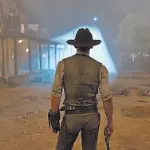Gazed by “others”
When thinking about another film released this year, “Oppenheimer,” a striking similarity comes to mind regarding the scenes of internal interrogations of Oppenheimer under the directive of Strauss after the war. Places like a courtroom or quasi-court inherently possess a strong dramatic and multifaceted potential.
Courtroom scenarios can become the intersections of multiple space-time happenings. In the process of investigation, everything from the past would be reenacted due to media storage, forcing the accused to unnaturally retrace their history. The most astonishing scene involves a USB drive containing recordings of Sandra and her husband Samuel's arguments, played publicly in court, while on the other side, a computer instantly transcribes it into text records. Casual oral expressions from daily life, even angry remarks made in moments of irrationality, are promptly recorded in a cold and rigid manner, becoming courtroom evidence that sends shivers down one's spine.

The reason why the interrogation process is so painful lies in its display of every minute detail, expanding extensively (across temporal and spatial dimensions) and exposing not only personal privacy but also subjecting each detail to a psychological analysis by the public. The most vivid portrayal of this sensation comes in a surreal scene in “Oppenheimer,” where, during the interrogation, the abrupt insertion of a surreal shot depicts Oppenheimer naked, seated in the courtroom chair. This process is underscored by Daniel's words when he appears in court: “When we lack evidence, to determine how something happened, we must look further, just as this trial does.”
On the other hand, the courtroom can also place numerous topics on the same platform for discussion. In “Anatomy of a Fall,” we witness discussions of marital communication, family upbringing, work, sexual orientation, and the struggles of women's survival. These topics, which do not inherently have a direct connection, seem predestined to converge under a retrospective viewpoint, as if the gears of fate are silently turning. This narrow retrospective viewpoint implies a strong sense of causality, making it appear as if everything occurs sequentially. If a couple had an argument one day, then the next day, the wife would be the culprit for the husband's fall. This intense and inevitable connection contradicts the flow of life. For Sandra, it's not just about proving she didn't commit a crime but also explaining her entire life, even accounting for various societal phenomena—why the wife's career is flourishing while the husband's is dwindling, why the husband lacks sexual prowess while the wife engages in extramarital affairs, or even becoming a victim of the inherent distrust between individuals. With so many witnesses willing to believe in a dead man with no evidence, pointing their fingers at the living, Sandra, being at the witness stand, is also standing up for everyone.

What's even more interesting is how the passersby in Samuel's life suddenly become important witnesses, given the right to speak with a moment's interaction. They casually enter the intricate structure of a family, laden with personal biases, attempting to ascribe grand and universal conclusions.
This leads to a simple yet profound question: why do we willingly accept to be gazed by 'others' and even gaze ourselves in the way that others gaze us?
Intrusion of “the Real”
Experiences like these, where an innocent person undergoes intense scrutiny to prove their innocence, can be seen as an intrusion of “the Real.” The English title of “Anatomy of a Fall” directly points to Samuel's fall from the roof, but also to the unexpected, abrupt, and intrusive intrusions of “the Real” into one's life.
For a definition of “the Real,” one can refer to Žižek, who provides many examples from popular culture. Quoting a passage from “Looking Awry”:
"The Symbolic Order attempts to mend rifts but ultimately fails. This crevice occasionally erupts in a rather magnificent manner, reminding us of how fragile the Symbolic Order is. Constructed relying on a certain 'repression' and the neglect of the Real of desire, the 'social reality' is nothing but a fragile, symbolic spider's web that can crumble at any moment due to the intrusion of the Real."
Samuel's fall from the roof is one such gruesome face of the Real, which suddenly unfolds in front of Sandra. After the fall, Sandra, who already had few friends in the foreign land, experiences the disintegration of the Symbolic Order, with accusations from all around, regardless of whether they know her and most significantly, with crisis of her son, Daniel's trust.

This intrusion of the Real is evident in the impact of the media. Sandra, a writer whose life revolves around words, not only faces the pressing question of the two recordings during the trial (the interview with the female student and the argument with her husband), but after the trial, she is still pursued by news reporters seeking sensational stories, surrounding her with live cameras. This presents an intriguing paradox. On one hand, traditional written media diminishes in the face of new media. When the accused is compelled to organize and structure their continuous and uncontrollable flow of life with words in court, recounting history and “truth,” it's an unnatural demand. This struggle to jump between languages (from French to English, interestingly, as Sandra is German and she never speaks for herself in her mother tongue) doesn't lead to a clear victory because no language escapes this structure. When we consider the similarities between “words” (language) and “things” (the world), we create an illusion that there is a truth behind language, which the film emphasizes as the “fact.” We will find out that “there is no truth.” Furthermore, we can never strictly or accurately speak of what we observe. Our expression and thought are merely replacing fluid reality with rigid images (“Gilles Deleuze”), which Sandra continuously refers to as “those are merely fragments,” and thus “distorted descriptions.”
On the other hand, we see that Samuel was continually trying to regain his dwindling agency before his death. He claimed that Sandra took away his work. While it's neither possible nor necessary to delve into a literary debate here, on the significance and importance of a 20-page outline for a complete novel of over 300 pages, we could still sense that, the dispute here seems to revolve around more than just a novel. It appears to be a struggle for narrative control within the family structure or even social reputation. Although Kittler repeatedly emphasizes that the use of “theory” must be confined to specific historical categories, it might be inappropriate to cite upcoming theories. However, we can still glimpse a distant history of the struggle for speech between the sexes within the closed loop of the discourse network in the 1800s:
"Modern male individuals receive language from females. However, nature or women cannot speak clearly, so it must be taught by male subjects, such as their fathers or authoritative figures like Lindhörst. These male subjects transform the language of women or nature into poetry and literature. First, this product, in turn, is read by many female readers, and they will learn how to speak and can then teach language. Secondly, philosophers like Hegel read this product, and these philosophers rely on the abundance of meaning permeating the system to provide metaphysical rationalization and legitimation at the level of new educational and literary practices.” (“Kittler on Media”)
We cannot know whether Samuel carried a utopian vision of male narrative dominance from the Romantic period, but in “Anatomy of a Fall,” we see the discontent generated from the fact that the volume of women's voices exceeds those of men.
A Female Director, a Female Perspective?

This brings us to the final, inevitable topic. Given the current circumstances and as the third female director to receive the Palme d'Or, it is challenging to analyze Justine Triet's work without considering her female identity and the label of a female director? As a film with a female protagonist, the conflicts between Sandra, her husband Samuel and the prosecutor's assertiveness undoubtedly provide coordinates for the real-life challenges faced by “successful women” today. When a husband dies, the wife is the first to be accused, rather than the child’s “patricide,” and everyone is delighted to witness the “mother" returning to her position in the family.








Share your thoughts!
Be the first to start the conversation.